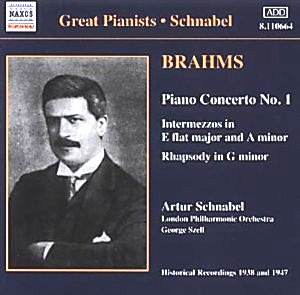 Composer: Johannes Brahms
Composer: Johannes Brahms
Works: Piano Concerto No. 1 in D minor, Op. 15; Intermezzo in E flat, Op. 117/1; Intermezzi in A minor, Op. 116/2; Rhapsody in G minor, Op. 79/2
Performers: Artur Schnabel (pianoforte), London Philharmonic Orchestra / George Szell (conducting)
Recording: Recorded 9.1. and 18.12.1938, EMI Abbey Road Studio No. 1 (concerto) and 4.6.1947, EMI Abbey Road Studio No. 3 (solo pieces)
Label: NAXOS Historical 8.110664
Johannes Brahms, a titan of the Romantic canon, imbued his compositions with a depth of emotion that stands as a testament to the human experience. His Piano Concerto No. 1 in D minor, a work born out of personal strife and ambition, encapsulates the tumult of his early years as he navigated the complexities of life and art. Artur Schnabel’s interpretation of this monumental score, alongside the London Philharmonic Orchestra under George Szell’s baton, presents an engaging dialogue between the soloist and the orchestra, illuminating the work’s intricate textures and emotional weight.
Schnabel’s performance is notable for its rich tonal quality, a factor that has often been overshadowed by the myths surrounding his technique. The initial orchestral tutti sets a dramatic stage; Szell conducts with a clarity that allows the layered phrases of Brahms to unfold organically. Schnabel’s entry is nothing short of revelatory—his piano sound, once criticized for being “hollow,” now resonates with a warmth and fullness that commands attention. The melding of his sound with Szell’s disciplined orchestration creates a compelling interplay, particularly in the first movement, where Schnabel navigates the often sprawling structure with a natural ease that belies the inherent technical challenges.
The Adagio, frequently a litmus test for interpretative nuance, reveals Schnabel’s ability to stretch time without sacrificing momentum. Here, the spaciousness of his phrasing, coupled with Szell’s subtle orchestral support, results in a reading that is gravely expressive. Schnabel’s choice to linger on certain notes enhances the lyrical quality of the movement, allowing the listener to savor Brahms’s rich harmonic language. The finale, marked by its spirited energy, showcases Schnabel’s command over the instrument. While earlier critiques may have labeled his phrasing as “snatched” or “lumpy,” this performance contradicts those notions, presenting a finale that is characterful and coherent.
The two Intermezzi and the Rhapsody provide a rewarding contrast to the concerto’s grandiosity. Schnabel’s articulation in the Intermezzi is notable for its luminous textures; he deftly realizes Brahms’s counterpoint, demonstrating a mastery that penetrates the emotional core of the music. The central section of Op. 117/1, with its potential for muddled execution among less seasoned interpreters, is handled with precision and depth, showcasing Schnabel’s profound understanding of the work’s delicate structure. The Rhapsody in G minor serves as a further testament to his interpretative prowess, where the clarity with which he separates melody from accompaniment reveals a command over the piano that is reminiscent of finely-tuned ensemble playing.
The recording quality, produced under the careful supervision of Mark Obert-Thorn, has been significantly enhanced from its original state. The early 20th-century engineering, often criticized for bluntness, now captures Schnabel’s nuanced touch and the orchestra’s vibrant sound, though some upper-register stridency remains. This sonic balance allows the listener to appreciate the fullness of Schnabel’s tone while also acknowledging the inherent limitations of the recording era.
Schnabel’s Brahms is essential listening, not merely for its historical value but for its artistic integrity. This recording stands alongside other great interpretations by the likes of Clifford Curzon and Rudolf Serkin, yet Schnabel’s unique voice in the Brahmsian landscape is irreplaceable. The combination of his interpretative depth and Szell’s meticulous conducting results in a performance that resonates with both emotional intensity and technical brilliance.
A listening experience that melds historical significance with profound musical insight, Schnabel’s recordings reaffirm his status as one of the great Brahms interpreters of the 20th century. This release is not only an invaluable addition to the Brahms discography but a celebration of musicianship that continues to inspire.



